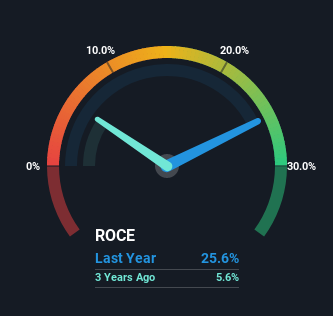If we want to find a potential multi-bagger, often there are underlying trends that can provide clues. Typically, we'll want to notice a trend of growing return on capital employed (ROCE) and alongside that, an expanding base of capital employed. Ultimately, this demonstrates that it's a business that is reinvesting profits at increasing rates of return. With that in mind, the ROCE of Bri-Chem (TSE:BRY) looks great, so lets see what the trend can tell us.
Return On Capital Employed (ROCE): What Is It?
For those who don't know, ROCE is a measure of a company's yearly pre-tax profit (its return), relative to the capital employed in the business. To calculate this metric for Bri-Chem, this is the formula:
Return on Capital Employed = Earnings Before Interest and Tax (EBIT) ÷ (Total Assets - Current Liabilities)
0.26 = CA$7.8m ÷ (CA$78m - CA$48m) (Based on the trailing twelve months to December 2022).
Therefore, Bri-Chem has an ROCE of 26%. In absolute terms that's a great return and it's even better than the Trade Distributors industry average of 20%.
See our latest analysis for Bri-Chem

Historical performance is a great place to start when researching a stock so above you can see the gauge for Bri-Chem's ROCE against it's prior returns. If you'd like to look at how Bri-Chem has performed in the past in other metrics, you can view this free graph of past earnings, revenue and cash flow.
So How Is Bri-Chem's ROCE Trending?
Bri-Chem has not disappointed with their ROCE growth. Looking at the data, we can see that even though capital employed in the business has remained relatively flat, the ROCE generated has risen by 86% over the last five years. So our take on this is that the business has increased efficiencies to generate these higher returns, all the while not needing to make any additional investments. The company is doing well in that sense, and it's worth investigating what the management team has planned for long term growth prospects.
On a separate but related note, it's important to know that Bri-Chem has a current liabilities to total assets ratio of 61%, which we'd consider pretty high. This can bring about some risks because the company is basically operating with a rather large reliance on its suppliers or other sorts of short-term creditors. Ideally we'd like to see this reduce as that would mean fewer obligations bearing risks.
The Key Takeaway
In summary, we're delighted to see that Bri-Chem has been able to increase efficiencies and earn higher rates of return on the same amount of capital. Since the total return from the stock has been almost flat over the last five years, there might be an opportunity here if the valuation looks good. That being the case, research into the company's current valuation metrics and future prospects seems fitting.
If you'd like to know more about Bri-Chem, we've spotted 4 warning signs, and 2 of them don't sit too well with us.
Bri-Chem is not the only stock earning high returns. If you'd like to see more, check out our free list of companies earning high returns on equity with solid fundamentals.
Valuation is complex, but we're here to simplify it.
Discover if Bri-Chem might be undervalued or overvalued with our detailed analysis, featuring fair value estimates, potential risks, dividends, insider trades, and its financial condition.
Access Free AnalysisHave feedback on this article? Concerned about the content? Get in touch with us directly. Alternatively, email editorial-team (at) simplywallst.com.
This article by Simply Wall St is general in nature. We provide commentary based on historical data and analyst forecasts only using an unbiased methodology and our articles are not intended to be financial advice. It does not constitute a recommendation to buy or sell any stock, and does not take account of your objectives, or your financial situation. We aim to bring you long-term focused analysis driven by fundamental data. Note that our analysis may not factor in the latest price-sensitive company announcements or qualitative material. Simply Wall St has no position in any stocks mentioned.
About TSX:BRY
Bri-Chem
Engages in the wholesale distribution of oilfield chemicals for the oil and gas industry in North America.
Good value with adequate balance sheet.
Market Insights
Community Narratives




